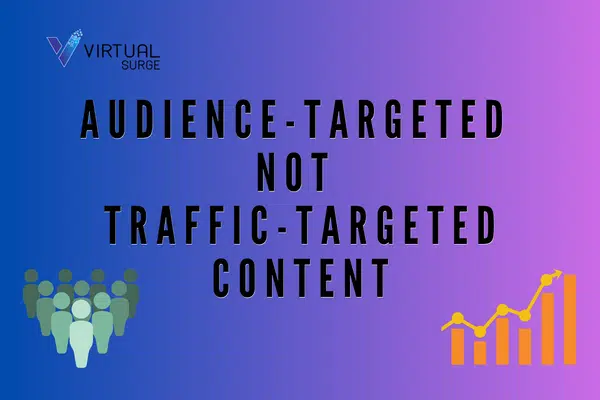
by shannon | Oct 10, 2023 | Baltimore SEO, Posts
Create Satisfying and Helpful Content Using Storytelling
Engaging your audience is vital to building a loyal following as a content creator.
But how do you create content that truly resonates with your target audience?
The secret sauce is storytelling.
Humans have used storytelling for thousands of years to communicate ideas, share experiences, and connect with others. It’s a powerful tool that can help you create more engaging content that captures your audience’s attention and keeps them coming back for more.
So, how exactly does storytelling work? And how can you use it to improve your content marketing strategy? Let’s dive in.
What is Storytelling?
At its core, storytelling is the art of communicating a message through a narrative. It’s about taking your audience on a journey, whether that’s through a fictional story, a personal anecdote, or a case study.
The power of storytelling lies in its ability to evoke emotions and create connections. When we hear a story, our brains release oxytocin, a hormone that helps us bond with others and feel empathy. It makes us more receptive to the communicated message and more likely to remember it.
How Storytelling Can Help You Create More Engaging Content
Now that we understand storytelling basics, let’s explore how it can help you create more engaging content.
Storytelling makes your content relatable.
One of the biggest challenges in content marketing is creating content that resonates with your target audience. Incorporating storytelling into your content can make it more relatable and relevant to your audience’s experiences.
For example, if you’re writing a blog post about the challenges of starting a business, you could share a personal anecdote about your struggles. It makes the content more engaging and helps your audience feel like they’re not alone in their experiences.
Storytelling creates an emotional connection.
As we mentioned earlier, storytelling has the power to evoke emotions. By tapping into your audience’s emotions, you can create a deeper connection with them and make your content more memorable.
For example, if you’re creating a video ad for a charity, you could tell a story about a person whose life was changed by the charity’s work. It would create an emotional connection with the audience and make them more likely to donate.
Storytelling adds context and depth.
When you tell a story, you can provide context and depth to your message. It can help your audience better understand the message you’re trying to convey.
For example, if you’re creating a product demo video, you could tell a story about a customer who used the product to solve a specific problem. It would provide context for the product’s work and show the audience how it could benefit them.
Storytelling sets you apart.
In a crowded marketplace, it can be challenging to stand out. By incorporating storytelling into your content, you can differentiate yourself from your competitors and create a unique brand identity.
Examples of Storytelling
When it comes to storytelling, many approaches can be employed to convey your message effectively.
A particularly impactful type of narrative is the customer success story. By showcasing the benefits of your product or service through the lens of a satisfied customer, you can provide valuable social proof to potential clients and inspire confidence in the quality of your offerings.
Another powerful storytelling angle is the behind-the-scenes story. By offering readers a glimpse into the inner workings of your company, you can humanize your brand and foster a sense of connection with your audience.
For example, if you’re a clothing brand, you could create a series of videos that tell the stories of the people who make your clothes. It would set you apart from other clothing brands and create a more personal connection with your audience.
Additionally, stories about your company’s history or mission can be tremendously compelling in establishing trust and creating a shared sense of values with your target demographic.
By thoughtfully considering the different types of stories you can tell and tailoring your content accordingly, you can maximize your impact and achieve your business goals.
How To Incorporate Storytelling Into An Existing Content Marketing Strategy
One way to incorporate storytelling into an existing content marketing strategy is to identify the key messages you want to convey to your target audience. Once you clearly understand your messaging, you can start brainstorming different stories that help illustrate those messages. For instance, consider creating customer success stories, behind-the-scenes stories, or stories about your company’s history or mission.
Another critical step is to think about using visuals to enhance your storytelling. It might include incorporating images, videos, or infographics into your content to help bring your stories to life. For example, you could create a video that tells a compelling story about a customer’s experience with your product or service.
Finally, it would help always to keep your audience in mind when creating your content. Think about what types of stories will resonate with your target audience and how to use those stories to build a deeper connection with them. By incorporating storytelling into your content marketing strategy thoughtfully and strategically, you can create more engaging and compelling content that helps drive results for your business.
Final Thoughts
Storytelling is a powerful tool to help you create more engaging content and build stronger connections with your audience. By incorporating storytelling into your content marketing strategy, you can differentiate yourself from your competitors and create a unique brand identity.
Remember, the key to compelling storytelling is to make your content relatable, create an emotional connection, add context and depth, and set yourself apart. With these elements in place, you can create content that truly resonates with your target audience and keeps them returning for more.
This article was originally posted at Virtual Surge.

by shannon | Sep 24, 2023 | Baltimore SEO
In the ever-evolving landscape of digital content and search engine optimization (SEO), the concept of Author Authority has emerged as a pivotal force shaping the way we perceive and interact with online information. This article delves deep into the intricacies of Author Authority, shedding light on its significance, the evolution it has undergone, and its multifaceted impact on the digital realm.
Defining Author Authority
Author Authority, at its core, represents the measure of an individual’s expertise, trustworthiness, and credibility within a specific field or domain. It goes beyond mere content creation and extends to the author’s influence, recognition, and reputation in their respective niche. In essence, it is the digital manifestation of one’s stature as a subject matter expert.
Importance of Author Authority in SEO
In the ever-competitive digital arena, where millions of pieces of content flood the internet daily, Author Authority serves as a beacon of reliability for both search engines and users alike. Google, in particular, has placed increased importance on Author Authority as a means of filtering and ranking content. High Author Authority often translates to higher search engine rankings, improved click-through rates, and enhanced user trust.
The Evolution of Author Authority
The journey of Author Authority can be traced back to the early days of the Internet when the emphasis was primarily on keyword optimization and domain-level metrics. However, as search engines became more sophisticated and user-centric, the focus shifted towards identifying not just what is being said but who is saying it. This shift marked the evolution of Author Authority as a prominent factor in content ranking.
Understanding Author Authority
What is Author Authority?
Author Authority, while closely related to Domain Authority, distinguishes itself by honing in on the individual behind the content. It is a multifaceted metric that encompasses an author’s expertise, trustworthiness, and credibility, often displayed through their body of work, associations, and industry recognition.
Key Elements of Author Authority
Expertise: The foundation of Author Authority lies in the author’s knowledge and mastery of their subject matter. Demonstrating in-depth understanding and proficiency in their niche positions them as authorities.
Trustworthiness: Trust is the currency of the digital realm. An authoritative author is one whose audience and peers have faith in, relying on their information as accurate and reliable.
Credibility: Credibility is built through consistent, high-quality work and ethical conduct. It solidifies an author’s reputation and fosters trust among readers.
How Author Authority Differs from Domain Authority
Domain Authority primarily assesses the trustworthiness and credibility of a website as a whole. In contrast, Author Authority zeroes in on the individual creating the content. It is a more granular metric that acknowledges that not all content creators within a domain are equal in expertise and trustworthiness.
The Role of E-A-T in Author Authority
Explaining E-A-T (Expertise, Authoritativeness, Trustworthiness)
E-A-T, as coined by Google, encapsulates the essence of Author Authority. Expertise signifies the author’s knowledge, Authoritativeness relates to their position in the field, and Trustworthiness underscores their reliability.
Google’s Emphasis on E-A-T
Google’s algorithm updates, such as the Medic Update, have underscored the significance of E-A-T in content ranking. Understanding and adhering to E-A-T guidelines have become imperative for authors and content creators aiming to thrive in the digital realm.
How E-A-T Impacts Search Rankings
E-A-T isn’t merely a buzzword; it directly influences how search engines assess and rank content. Websites and authors with high E-A-T scores are more likely to secure top positions in search results, thereby gaining greater visibility and authority.
Case Studies on E-A-T and Author Authority
Real-world case studies illustrate the tangible impact of E-A-T on Author Authority. We’ll explore instances where adherence to E-A-T principles led to significant improvements in search rankings and user trust.
Building Author Authority
Building Author Authority is not an overnight endeavor; it requires a well-thought-out strategy, dedication, and consistency. In this section, we delve into the actionable steps and methodologies for establishing your presence as a recognized authority in your chosen field.
Strategies for Establishing Author Authority
Creating High-Quality Content
Content is the cornerstone of Author Authority. Content that is well-researched, insightful, and valuable to the audience not only attracts readers but also garners respect and recognition within the industry.
Guest Blogging and Contributions
Guest blogging on reputable websites and contributing to authoritative publications in your niche can significantly boost your Author Authority. These platforms provide a broader audience and an opportunity to showcase your expertise.
Social Media Presence
In the digital age, a strong Social Media Presence is essential for authors looking to build their authority. Active engagement, sharing valuable insights, and fostering meaningful connections can elevate your status as a thought leader.
Leveraging Personal Branding
Author Authority is intrinsically tied to your Personal Brand. Craft a compelling and consistent personal brand that reflects your expertise, values, and unique perspective. Your brand should become synonymous with credibility and trust.
Obtaining Authorship and Byline Recognition
Securing authorship and byline recognition of your content is pivotal. It not only boosts your credibility but also makes it easier for readers to identify and connect with your work across different platforms.
Tools and Metrics for Measuring Author Authority
Google’s Authorship Markup
Google’s Authorship Markup is a powerful tool for authors. It links your content to your Google Profile, providing a visible authorship stamp on search results, enhancing click-through rates, and establishing your authority.
Google Authorship vs. Author Rank
Distinguish between Google Authorship, which focuses on attribution, and Author Rank, which speculates a ranking mechanism based on author authority. Both play significant roles in establishing Author Authority.
Tracking Author Authority Metrics
Metrics such as Moz’s AuthorRank and SEMrush’s Author Impact Score quantify your Author Authority. These tools analyze your content’s performance, social engagement, and backlinks to gauge your influence.
Case Studies on Author Authority Measurement
Explore real-world examples where authors employed these tools to measure and improve their Author Authority. These case studies shed light on the practical application of metrics in the digital landscape.
The Impact of Author Authority on SEO
Understanding how Author Authority influences SEO is crucial for anyone looking to excel in the digital realm. In this section, we uncover the intricate relationship between Author Authority and search engine rankings.
How Author Authority Influences Search Engine Rankings
Author Authority serves as a decisive factor in determining content visibility on search engine results pages. Google’s algorithms favor content from authoritative authors, leading to higher rankings and increased organic traffic.
Authorship in Featured Snippets and Knowledge Graph
Highly authoritative authors often find their content featured in Google’s Featured Snippets and Knowledge Graph, positioning them as definitive sources of information.
The Link between Author Authority and Backlinks
Author Authority is closely linked to the acquisition of high-quality Backlinks. Authoritative authors naturally attract backlinks from other reputable websites, further solidifying their position in search results.
Author Authority’s Role in Content Distribution
Content created by authoritative authors tends to be shared and distributed more widely. Their work has a greater potential to go viral, resulting in increased brand exposure and engagement.
Challenges and Misconceptions
Even as Author Authority gains prominence in the digital landscape, it’s not without its challenges and misconceptions. Understanding these hurdles and dispelling myths is essential for authors striving to build their authority effectively.
Common Misconceptions about Author Authority
Misconception 1: Author Authority is solely about the quantity of content produced.
Misconception 2: Author Authority can be built overnight.
Misconception 3: It’s only about self-promotion; humility doesn’t matter.
Debunking these misconceptions helps authors adopt a more realistic and sustainable approach to building their authority.
Challenges in Building and Maintaining Author Authority
Challenge 1: Fierce Competition – In many niches, there’s intense competition among authors vying for authority status. Standing out amidst the crowd can be daunting.
Challenge 2: Consistency – Maintaining a consistent level of quality and engagement over time can be challenging, especially in rapidly evolving industries.
Challenge 3: Adhering to E-A-T Guidelines – Aligning with Google’s E-A-T guidelines requires continuous effort and adherence to best practices, which can be demanding.
Addressing Criticisms and Controversies
Authors with authority may also face criticism and controversies. Navigating these situations with grace and professionalism is essential. We’ll explore strategies for addressing negative feedback and controversies while safeguarding your Author Authority.
Case Studies and Success Stories
Real-world examples provide valuable insights into the practical application of Author Authority. In this section, we examine instances where authors successfully leveraged their authority to achieve remarkable results.
Successful Examples of Authors with High Authority
We showcase authors who have risen to the pinnacle of authority in their respective niches. Their journeys and strategies serve as inspiring blueprints for aspiring authors.
How Author Authority Transformed Businesses
Author Authority isn’t just about personal recognition; it can profoundly impact businesses. We’ll explore cases where businesses harnessed the authority of their authors to boost brand reputation and revenue.
Learning from Author Authority Success
Key takeaways from these success stories offer actionable advice for authors looking to emulate their achievements. These insights shed light on the strategies and principles that lead to Author Authority success.
Future Trends and Predictions
The digital landscape is ever-evolving, and Author Authority is no exception. In this section, we peer into the crystal ball and examine the future of Author Authority in SEO.
The Future of Author Authority in SEO
As search engines and algorithms become more sophisticated, the role of Author Authority is likely to expand. We discuss potential shifts and developments that authors should anticipate.
How AI and NLP Will Impact Author Authority
Artificial Intelligence (AI) and Natural Language Processing (NLP) are poised to play significant roles in assessing Author Authority. We explore how these technologies may influence the way Author Authority is measured and valued.
Predictions for Changes in Google’s Algorithm
Google’s algorithm is constantly evolving. We offer insights into potential algorithmic changes that could impact Author Authority and content ranking in the future.
Expert Opinions
To provide a well-rounded perspective, we’ve gathered insights from industry experts who have navigated the complexities of Author Authority.
Interviews with Industry Experts
Prominent experts in the field share their thoughts on the evolving landscape of Author Authority, offering invaluable guidance and predictions.
Insights on the Future of Author Authority
Experts provide unique insights into how Author Authority may evolve in the coming years and how authors can adapt to stay ahead.
Expert Tips for Aspiring Authors
Seasoned professionals offer practical tips and strategies for those aspiring to build their Author Authority from the ground up.
Conclusion
In the ever-competitive digital space, the Increased Emphasis on Author Authority is a trend that cannot be ignored. As we recap the significance of Author Authority and its multifaceted impact on SEO and content creation, we leave you with actionable takeaways for SEO Freelancers and Content Creators. Embrace Author Authority, invest in your expertise, and watch your digital presence soar.
Virtual Surge originally posted this article.

by shannon | Aug 21, 2023 | Baltimore SEO
In today’s dynamic digital landscape, where content reigns supreme, the success of your digital presence hinges upon a well-crafted content strategy. This strategy is the backbone of your online efforts, purposefully directing your content creation and distribution. Within this realm, the distinction between audience-targeted and traffic-targeted content is paramount, as it can be the key to unlocking meaningful engagement and long-term success.
Importance of Content Strategy
A robust content strategy is more than just a trend; it’s necessary. It lays the groundwork for your digital endeavors, providing a roadmap for what you create, when you share it, and where you share it. Without a clear strategy, your efforts could be akin to shooting arrows in the dark, hoping to hit something meaningful. By defining your content strategy, you align your efforts with your business goals, ensuring every piece of content serves a purpose.
Defining Audience-targeted and Traffic-targeted Content
Two distinct approaches emerge in the content landscape: audience-targeted and traffic-targeted content. Audience-targeted content focuses on catering to the needs, preferences, and pain points of a specific group of people – your target audience. Conversely, traffic-targeted content emphasizes attracting large visitors, often to boost numbers, but not necessarily building deep connections.
Understanding Audience-targeted Content

Identifying Your Target Audience
Central to the success of audience-targeted content is a clear understanding of your target audience. This entails delving into demographics, psychographics, and behaviors. Who are they? What motivates them? What challenges do they face? The answers to these questions guide your content direction.
Creating Buyer Personas for Precise Targeting
Buyer personas – detailed representations of your ideal customers – offer invaluable insights. Craft personas that go beyond superficial demographics and uncover your audience’s motivations, pain points, and aspirations. These personas enable you to craft content that speaks directly to their hearts and minds.
Tailoring Content to Address Audience Needs
Audience-targeted content is like a tailored suit – it fits perfectly. By addressing your audience’s unique needs and concerns, you position yourself as a reliable source of solutions. This fosters trust, which is a cornerstone of long-lasting customer relationships.
Downsides of Traffic-targeted Content

Focusing Solely on Numbers
While high traffic numbers might seem impressive, they hold little value if they don’t convert into meaningful engagement. Focusing solely on numbers can lead to a misguided strategy that fails to connect with your audience on a deeper level.
Bouncing Traffic and High Bounce Rates
Traffic-targeted content often attracts visitors who aren’t truly interested in what you offer. As a result, bounce rates – the percentage of visitors who leave your site after viewing only one page – can be alarmingly high. This indicates a lack of relevance and engagement.
Lack of Engagement and Conversion
Traffic without engagement is like a vehicle without fuel – it goes nowhere. Content not targeted toward your audience’s needs might attract visitors, but it fails to engage them or encourage conversion. This lack of engagement can ultimately harm your brand’s reputation.
Stay tuned for the next part of the article, where we delve into the benefits of audience-targeted content and how it can transform your digital strategy.
Benefits of Audience-targeted Content

Building Meaningful Connections
Audience-targeted content allows you to build connections that transcend fleeting interactions. You establish a genuine rapport when your content resonates with your audience’s needs and interests. This connection forms the basis of trust, loyalty, and advocacy.
Higher Engagement and Interaction
Content that speaks directly to your audience’s concerns ignites engagement. They are likelier to comment, share, and participate in discussions around topics that matter to them. This enhances your online community and extends your content’s reach.
Improved Conversion Rates and ROI
Engaged audiences are more likely to take desired actions, whether signing up for your newsletter, purchasing, or sharing their information. The result? Improved conversion rates and a healthier return on investment (ROI) for your content efforts.
Crafting Audience-targeted Content
In-depth Research and Analysis
To truly understand your audience, meticulous research is essential. Dive into their preferences, pain points, language, and digital behavior. Analyze existing data, conduct surveys, and explore social media interactions to gain a comprehensive understanding.
Addressing Specific Pain Points
Your audience seeks solutions to their problems. Addressing their pain points directly in your content positions you as a problem solver. Provide actionable insights and advice that alleviate their concerns, demonstrating your expertise.
Personalization and Relatability
The era of one-size-fits-all content is over. Personalization is the new standard. Tailor your content to speak directly to individual segments of your audience. Use relatable anecdotes, stories, and real-life examples to create a resonant connection.
Content Formats for Audience-targeted Approach
Educational Blog Posts
Deep-dive blog posts that provide valuable insights and practical guidance showcase your expertise and cater to your audience’s thirst for knowledge.
Problem-Solving Videos
Visual content that addresses common challenges and provides step-by-step solutions engages viewers and positions you as a trusted advisor.
Interactive Quizzes and Polls
Engage your audience with interactive content that entertains and provides valuable insights into their preferences and opinions.
Stay tuned for the subsequent sections, where we’ll explore leveraging data for content creation, implementing SEO for audience-targeted content, and measuring the success of your targeted strategy. Your journey toward effective content creation is just getting started.
Utilizing Data for Content Creation

Leveraging Analytics Insights
Your website analytics hold a treasure trove of information. Analyze which content resonates most with your audience, what drives engagement, and which channels bring the most valuable traffic. This data informs your content decisions.
Gathering Customer Feedback
Direct feedback from your audience provides invaluable insights. Conduct surveys, encourage comments, and actively listen to what your audience is saying. Their input can guide your content strategy and ensure it aligns with their needs.
Incorporating Trending Industry Data
Stay current by incorporating industry trends and data into your content. Sharing insightful industry reports, statistics, and expert opinions positions you as a thought leader and informs your audience.
Implementing SEO with Audience-targeted Content
Strategic Keyword Integration
Keyword research remains a cornerstone of SEO. Identify keywords that align with your audience’s search intent and incorporate them naturally into your content. This helps your content rank higher and reach the right eye.
Natural Language and Long-Tail Keywords
As search engines evolve, natural language and long-tail keywords are gaining importance. These keywords mimic how people speak and search, ensuring your content is discoverable by those seeking specific solutions.
High-Quality Backlinks from Relevant Sources
Build authority by acquiring high-quality backlinks from authoritative sources within your niche. These backlinks boost your SEO and enhance your credibility among your audience.
Measuring Success of Audience-targeted Strategy
Analyzing Engagement Metrics
Monitor metrics such as time on page, scroll depth, and click-through rates to gauge how engaged your audience is with your content. High engagement indicates content that resonates.
Tracking Conversion Rates
Conversion tracking reveals whether your audience is taking desired actions, such as signing up for newsletters or purchasing. This data reflects the effectiveness of your content in driving action.
Monitoring Social Media Shares and Comments
Social media is a barometer of content resonance. Track shares, comments, and interactions. More shares and meaningful discussions point to content that strikes a chord.
Avoiding Common Pitfalls
Overlooking Data Insights
Neglecting the data available to you leads to missed opportunities. Regularly review your analytics and adjust your strategy based on insights.
Neglecting Evolving Audience Preferences
Audience preferences are fluid. Stay attuned to shifts in your audience’s needs and adapt your content accordingly.
Being Too Niche or Too Broad
Balancing specificity with broader appeal is essential. Being too niche might limit your reach while being overly broad can dilute your content’s impact.
The journey towards audience-targeted content continues with a look into case studies showcasing brands that have excelled with this approach, followed by insights into future trends that will shape the content landscape. Let’s explore these next.
Case Studies: Brands Excelling with Audience-targeted Approach
Case Study 1: Company A’s Personalized Email Campaign
Company A leveraged audience insights to craft personalized email campaigns. They achieved higher open and click-through rates by tailoring content to individual preferences and needs, leading to improved conversions.
Case Study 2: Brand B’s Interactive Social Media Strategy
Brand B created interactive content that encouraged audience participation. Through quizzes, polls, and interactive posts, they fostered engagement and formed a community, resulting in a loyal following.
Stay tuned for the final section, where we’ll delve into the exciting future trends in audience-targeted content and conclude with a call to action that can transform your content strategy.
Future Trends in Audience-targeted Content
Embracing AI and Personalization Technology
Artificial intelligence will enable hyper-personalization, crafting content that adapts in real-time to individual preferences and behaviors.
Voice Search and Conversational Content
Creating content that aligns with conversational queries will be key to visibility as voice search gains traction.
Shifting SEO Focus toward User Intent
Search engines will increasingly prioritize content that fulfills user intent, rewarding content creators who truly address audience needs.
Conclusion
In the ever-evolving digital landscape, audience-targeted content is a beacon of relevance and engagement. By embracing the power of understanding your audience deeply, tailoring content to their needs, and strategically utilizing data and SEO, you pave the way for enduring success. As you embark on this content journey, remember that it’s not just about traffic; it’s about building connections, fostering engagement, and ultimately achieving long-term success through audience engagement.

by shannon | Aug 7, 2023 | Baltimore SEO
As the world’s most popular search engine, Google is constantly updating its algorithms to provide users with the most relevant and high-quality search results. One of the most important factors in determining the quality of a webpage is the content it contains, and Google has long used the E-A-T guidelines (Expertise, Authority, and Trustworthiness) to evaluate the credibility and quality of online content.
Recent Guideline Update
Recently, Google has added a new factor to the E-A-T guidelines: Experience. This means that Google now considers the experience of the author or creator when evaluating the quality of a content source. This is a significant change that will have a major impact on how content creators approach the creation of online content.
So, what does it mean for content creators? Well, it means that Google is placing an even greater emphasis on the expertise, authority, and trustworthiness of the author or creator of a piece of content. This is because Google wants to ensure that the content it displays in its search results is not only high-quality, but also created by experts who have a deep understanding of the topic they are writing about.
Important Factors
One of the key ways in which Google will evaluate the experience of a content creator is by looking at their online reputation. This includes factors such as the number of publications they have written for, the quality of those publications, and the level of engagement they have with their audience.
Another important factor will be the level of engagement that the content creator has with their audience. This includes things like the number of comments, likes, and shares that their content receives, as well as the level of engagement they have with their social media followers.
It’s important to note that the new experience factor is not just about the author or creator of a piece of content but also about the user experience. Google wants to ensure that the content it displays in its search results is not only high-quality but also provides a positive experience for the user.
The Intent of the Content
This means that content creators should focus on creating content that is not only informative and engaging but also easy to navigate and visually appealing. This includes things like using clear headings and subheadings, incorporating images and videos, and using a clean and easy-to-read layout.
In addition to creating high-quality content, content creators should also focus on building their online reputation and engaging with their audience. This includes things like building a strong social media presence, responding to comments and questions, and participating in online communities related to their niche.
Content Creators and Users
Ultimately, the new experience factor is a positive development for both content creators and users. By placing a greater emphasis on the experience of the author or creator, Google is ensuring that the content it displays in its search results is not only high-quality but also created by experts who have a deep understanding of the topic they are writing about.
For content creators, this means they need to focus on creating high-quality content that not only provides value to their audience but also demonstrates their expertise, authority, and trustworthiness. By doing so, they will be able to build a strong online reputation and increase their visibility in Google’s search results.
For users, this means they can trust that the content they find in Google’s search results is not only accurate and informative but also provides a positive experience. This will help them to find the information they need quickly and easily without having to wade through low-quality content that is created by individuals who lack expertise or authority in their field.
Final Thoughts
Overall, the addition of the experience factor to the E-A-T guidelines is a positive development that will help to ensure that online content is of the highest quality and provides a positive experience for users. Content creators who focus on creating high-quality content and building their online reputation will be well-positioned to take advantage of this new development and increase their visibility in Google’s search results.

by shannon | Jun 6, 2023 | Posts
7 Steps to Complete an SEO Audit
Search Engine Optimization (SEO) is critical to any successful digital marketing strategy. However, it’s more than a set-and-forget kind of job. To keep your SEO strategy effective and your website ranking high in search engine results, you must regularly perform an SEO audit.
An SEO audit is a health check for your website. It allows you to evaluate how well your website is optimized for search engines and identify areas for improvement. Here’s a step-by-step guide to performing your own SEO audit:
1. Start with a Crawl
The first step in an SEO audit is to crawl your website using an SEO crawler tool. This will help you get an overview of your website from an SEO perspective, and identify issues like broken links, duplicate content, missing tags, and errors in website structure.
Tools like Screaming Frog SEO Spider, SEMrush, or Ahrefs can help you with this process. They will crawl your website in the same way a search engine would allowing you to see your website as Google does.
2. Evaluate Your Website’s Structure and Design
Next, assess your website’s structure and design. A well-structured website is user-friendly and makes it easier for search engine bots to crawl and index your website.
Consider whether your website’s design is responsive and mobile-friendly, whether your pages load quickly, and if your website is easy to navigate. User experience (UX) is a critical ranking factor, and poor UX can lead to higher bounce rates and lower rankings.
3. Analyze Your On-Page SEO
On-page SEO refers to the optimization of individual pages on your website. It includes elements like title tags, meta descriptions, headers, and content.
Ensure that your title tags and meta descriptions are unique, include your target keywords, and are of the correct length. Your headers should be properly structured (H1 for main headers, H2 for subheaders, etc.) and also include your target keywords where appropriate.
The content on your pages should be high-quality, unique, and relevant to your audience. It should also be well-optimized for keywords without being overly stuffed.
4. Assess Your Off-Page SEO
Off-page SEO relates to factors outside your website that influence your rankings, primarily backlinks. In the eyes of search engines, backlinks from other websites to yours serve as endorsements of your content and can significantly boost your SEO if they are from high-quality, reputable sites.
Use a tool like Ahrefs or Moz’s Link Explorer to analyze your backlinks. Look at the total number of backlinks, the number of unique referring domains, and the overall quality of these links.
5. Review Your Website’s Content
Quality content is an important aspect of effective SEO. Review your content to ensure it’s valuable, relevant, and original. Duplicate or thin content (with little to no value) can hurt your SEO efforts.
Also, evaluate your content in terms of keyword optimization. Are you targeting the right keywords? Are these keywords integrated naturally within the content?
6. Conduct a Technical SEO Audit
Technical SEO refers to the technical aspects that affect your website’s visibility to search engines. This includes elements like site speed, mobile-friendliness, XML sitemaps, and schema markup.
Use Google’s PageSpeed Insights tool to assess your website’s loading speed. For mobile-friendliness, Google’s Mobile-Friendly Test tool can be beneficial. Your website should have a well-structured XML sitemap that you’ve submitted to Google Search Console, helping search engines understand your site structure.
7. Evaluate Your Local SEO (if applicable)
Assessing your local SEO is crucial if your business has a local component. This includes your Google My Business listing, online reviews, and local citations, which are sites that mention your business name, address, and phone number.
Your Google My Business listing should be complete, accurate, and optimized with relevant categories and a thorough business description. You should also manage and respond to your online reviews and ensure that your business’s information is consistent across all online platforms.
While performing an SEO audit can seem like a difficult task, it’s essential for keeping your SEO strategy on track. With the right tools approach, you can identify the strengths and weaknesses of your current strategy, make necessary adjustments, and keep your website well-optimized for search engines. SEO takes time, and regular audits can help you stay in the lead.
Don’t have time to do your own audit? Contact Virtual Surge, Baltimore SEO’s top team, today. We have a team of experts with extensive experience!









